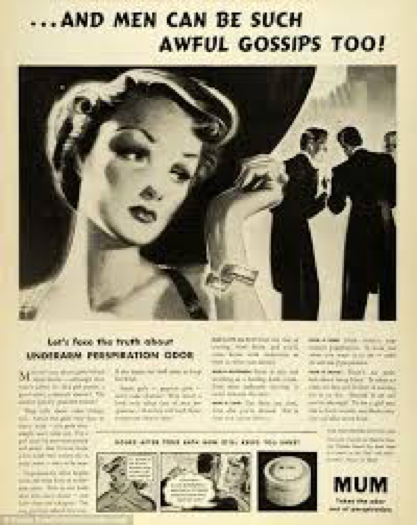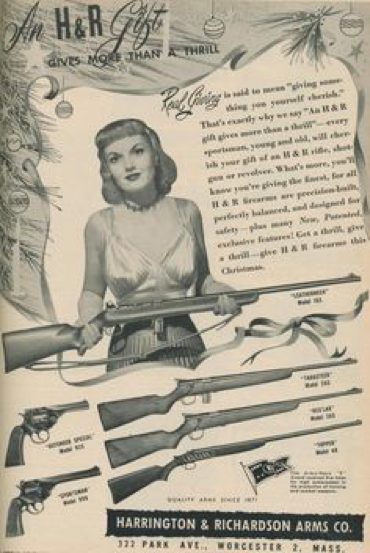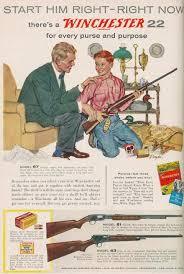
U.S. gun culture is unique. Though we make up just 5 percent of the world's population, it is estimated that Americans own between 35-50 percent of all guns worldwide. Behind this U.S. gun culture stands a $13.5Bn business. And advertising has played a crucial role in the growth and continued profitability of the gun industry.
Gun manufacturers have been highly successful in employing some of the most effective marketing techniques in the book.
Gun ads have long used the technique known in the business as "fear appeal".
That is, a company identifies (or creates) a potential concern or fear for which their product is the solution.
You may be more familiar with this in a context a little closer to home--like the early coining of the phrase "body odor." In the old days people used to find the way others smelled kind of attractive, and apparently even went so far as to pop a peeled apple under their armpit to pass on to their lover should they need a little pheromone-laden memento to sniff when apart. But in 1910, the term "BO"--short for body odor--was coined by advertisers, and women were targeted by ads which showed men talking about the way they smelled behind their backs.
So successful was this fear-generating strategy that the market for deodorant grew to become an $18.9 billion global market, and now for most of us (myself included), it is unthinkable to go without deodorant.
Other similar campaigns aimed at creating or exploiting anxieties followed on their heels. Bad breath, dandruff, dirty-sponge syndrome, the seven signs of aging, and now--wait for it--the seven signs of hair aging have us all feeling insecure and out there buying the offered solutions en masse.
What does this have to do with guns? Well, in the U.S., gun marketers have been uniquely successful in claiming their product is the answer to a fear--that of a home invasion. And yet-- deaths in a home-invasion situation account for less than 0.3 percent of all gun fatalities, yet HAVING a gun in the home substantially increases the chance that someone in in the house will be shot (with suicides, domestic violence and accidents involving guns and children the biggest risk factors).
And more recently, guns are being offered as the antidote to an increasing number and variety of mass shootings. After guns were used to kill 20 six- and seven-year-olds in Sandy Hook, the head of the NRA offered guns as the solution, proposing teachers be armed, an approach that has indeed been implemented in some parts of the country, and in response to the Aurora movie shooting that "Guns don't kill, Batman kills. Had someone in the audience been armed this tragedy could have been averted." And it seems that this advertising has been more effective as mass shootings have increased--according to a Gallup poll in 2000, 35 percent of Americans said they felt safer with a gun in the home compared to 63 percent in 2014.
And yet--these fears simply do not occur to the same extent (or at all) in other countries without widespread access to guns.
There have been a number of articles recently written by immigrants or visitors from countries like Canada and Japan who struggle to make sense of this logic. If you live in a country without widespread access to guns, you don't worry about being shot! The highly conservative Australian Prime Minister, John Howard, even wrote an op-ed in The New York Times, sharing his experience of implementing strict gun control measures, and the dramatic resultant drop off in gun deaths.
Of course fear is not the only strategy deployed in the marketing of guns--for many years, advertisers have worked hard to align guns with images of sexiness and manliness in the minds of consumers. Here's an image from a campaign from the 1940s :
For citizens who have been raised in this advertising-rich environment, which comfortably equates guns and safety, sexiness, and manliness, it can be hard to see the marketing for what it is. Perhaps it is easier if we think about cigarettes--which were also presented as the ultimate sexy accessory for years (manly men, and seductive, sophisticated women), that we can start to see that there is not always truth in advertising.
Of course, advertising is just one of the strategies deployed by gun manufacturers to increase profits. Others include increasing distribution by creating new forums such as gun shows and online retailers, and of course, counteracting any efforts to limit gun accessibility (including lobbying against background checks, gun-free zones, and even prohibiting pediatricians from speaking to parents about the risk of guns in the home). However, advertising makes a big difference.
The result of all this intelligence and effort is a booming business. But the problem is that unlike people buying overpriced shampoo, the consequence of gun advertising is a no-holds barred gun culture, high rates of gun ownership (between 210-310 million guns), almost half a million non-fatal gun victimization attempts per year, and an average of 31,500 gun-related fatalities per year (and for the first time last year, more people were killed by guns in the U.S. than by cars).
Advertising also acts to influence politicians. Politicians are consumers too. They can also be tricked into feeling the fear, and buying the idea that guns are the antidote. But perhaps, more insidiously, as advertising fuels profit growth, so too does it fuel the ability of manufacturers to finance political campaigns and gain political sway. Thus while sensible solutions proposed by frustrated and frightened citizens are repeatedly blocked, other laws are passed that make guns more widely available and more accessible. And so the gun grows, the cycle continues, and the rest of the world looks on in bewilderment.




